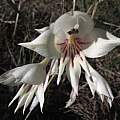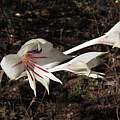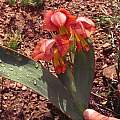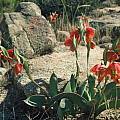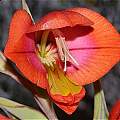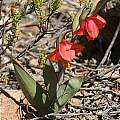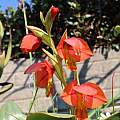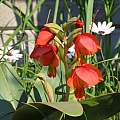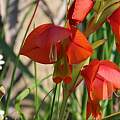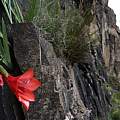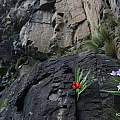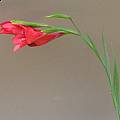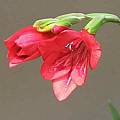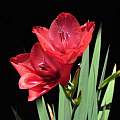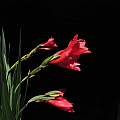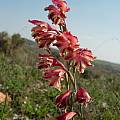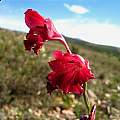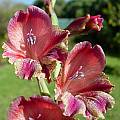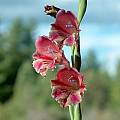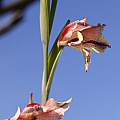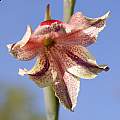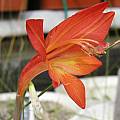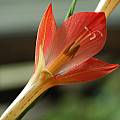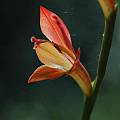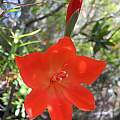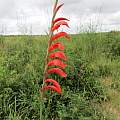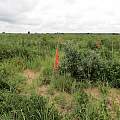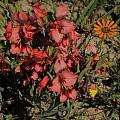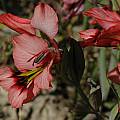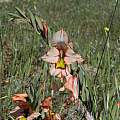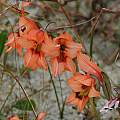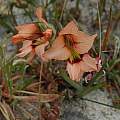Several species settle for these clear signal colors, often associated with bird pollination. This may result in very special flower shapes with long perianth tubes.
Though magenta is considered the basic red in printing color systems, we follow the common western color perception. Magenta colored Gladiolus can be found in the Purple Gladiolus index.
Page 1: G. abbreviatus... Page 3: G. meridionalis... Page 4: G. pulcherrimus... Page 5: G. stefaniae...
Gladiolus engysiphon G.J.Lewis is found in clay and granitic loam in renosterveld and grassland in the Langeberg Center (Swellendam to Mossel Bay). Growing from 35 to 50 cm high, it flowers March to April. The cream flowers with red median streaks are arranged in a 2 to 6 flowered spike. Photos taken by Rogan Roth in the southern Cape in April 2021. He first thought it was Gladiolus bilineatus which has a similar flower, distribution, and flowering time in the autumn. Both are pollinated by a species of long-proboscid fly. According to John Manning the lowest leaf in Gladiolus bilineatus always develops a short, sword-shaped blade, whereas the leaf blades in Gladiolus engysiphon are either absent entirely or needle-like. The arrangement of the leaves and the diameter of the stem is also different in the two species.
Gladiolus equitans Thunberg is very similar to Gladiolus alatus but has short, broad leathery leaves with raised margins and grows on rocky hills in Namaqualand. The first one was photographed in Namaqualand in August 2001 just after it rained by Mary Sue Ittner. The second photo was taken in about the same place in September 2006 by Bob Rutemoeller, but the plants were already in seed this time. The third picture was taken by Rod Saunders. The fourth and fifth photos were taken in habitat in the Kamiesberg by Andrew Harvie.
Photos below were taken by Alan Horstmann.
Gladiolus flanaganii Baker grows on the cliffs of the Drakensberg mountains in KwaZulu-Natal which form the border between Lesotho and South Africa. Long ago, plant collectors would risk death to see/collect these plants, thus it has gained the vernacular name "Suicide Lily". In milder climates maritime, it does well in a very well drained mix, full sun, and occasional watering. Water should be given often during hot spells. Keep the bulbs dry during its winter dormancy.
The photos below were taken by Callan Cohen of plants in habitat.
Photographs 1-2 taken by David Victor are of a wild collected material recently given to him by Danish friends. Photo 3-5 were taken by Nhu Nguyen who grows this in his Berkeley garden in a 1 gallon pot.
Gladiolus guthriei F.Bolus is a winter-growing species that occurs on rocky sandstone outcrops in the Western Cape. It incorporates plants formerly known as Gladiolus odoratus L.Bolus. It blooms in fall to early winter; April to June in its native range. Plants that will bloom send up a flowering stalk with very short leaf stubs on it. Plants not blooming in that year produce a long leathery leaf. The flowers generally have a pale yellow or straw base color, liberally decorated with mauve or dark magenta streaks and freckles. The result looks fairly dull from a distance, but the flowers reward close examination. They have a sweet scent. First four photos taken in Napier and Villiersdorp in the Overberg by Cameron McMaster. The fourth and fifth photos are of the Gladiolus odoratus form, blooming in December in California by Michael Mace.
Gladiolus huttonii (N.E.Br.) Goldblatt & M.P.de Vos syn Homoglossum huttonii N.E.Br is found on sandstone slopes in the southeastern Cape and flowers winter to spring. It has red to orange flowers with the lower tepals sometimes yellow. The first photo was taken by Bob Rutemoeller of a plant grown by Alan Horstmann. The next two pictures were taken by Mary Sue Ittner. Photos of many interesting hybrids of this species are found on the Gladiolus hybrids wiki page.
Gladiolus insolens Goldblatt & J.C.Manning grows in a few wet sites along streams and seeps in rocky areas on the higher slopes of the Piketberg in the western Cape. It has a spike of one to three bright scarlet flowers and five to seven narrow grey green leaves. Photo by Rachel Saunders.
Gladiolus magnificus (Harms) Goldblatt is a southern tropical African species found from central Angola through southern Zambia to western Zimbabwe. It is also found in the northern edges of Namibia and Botswana. In the past this species has been included in Antholyza under three species names as well as being included in Chasmanthe and Oenostachys. It has bright red flowers with a long perianth tube and reduced lower tepals with yellow markings. Tepals are very unequal with the dorsal the largest, hooded and horizontal. The laterals are broadly lanceolate and directed forward. It flowers in January and February. Photo from iNaturalist taken by Cody Coyotee Howard in Namibia and shared under a CC BY-NC license.
Gladiolus meliusculus (G.J.Lewis) Goldblatt & J.C.Manning, syn. Gladiolus alatus var. meliusculus is found on low hills and flats on the western Cape coastal plain where it grows in sandy sites formed from decomposed granite or sandstone that are waterlogged during the period of growth. Flowers are salmon, brick-red or orange with yellow markings on the lower tepals. Gladiolus meliusculus differs from Gladiolus alatus by having shorter stamens and the yellow on the lower tepals is less pronounced and edged by a band of red-purple and the upper halves are pink to orange. The first three photos were taken by Mary Sue Ittner and Bob Rutemoeller September 2006 near Darling. The other two were taken near Brackenfell on Rod and Rachel Saunders' property where they are growing this species.
Page 1: G. abbreviatus... Page 3: G. meridionalis... Page 4: G. pulcherrimus... Page 5: G. stefaniae...
